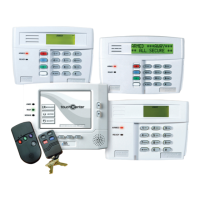Do you have a question about the First Alert FA1660C and is the answer not in the manual?
| Brand | First Alert |
|---|---|
| Model | FA1660C |
| Category | Security System |
| Language | English |
Introduction to the First Alert Partitioned Security System and its components.
Explains sharing one physical alarm system among different users.
Networks up to eight FA1660C control panels for unified management.
Describes how sensing devices are assigned to distinct zones for monitoring.
Explains the always-on fire protection feature of the security system.
Details the four arming modes and bypass capabilities for burglary.
Recommends the installation of CO detectors for safety.
Describes how alarms are indicated and silenced.
How the system stores and displays alarm conditions.
Feature for programming and executing command sequences.
Automating system functions based on time.
Controlling devices like lights and appliances by time.
Method for switching between system partitions.
Using a master keypad to view all partition statuses.
Built-in on-keypad instructions for system procedures.
Remote system control via telephone.
Keypad features, operation, and important warnings.
Details on the Alpha Keypad's advanced display features.
Explains the core keypad functions like OFF, AWAY, STAY, etc.
Covers Chime, Ready, Quick Arming, and keypad indicators.
Explains exit and entry delay periods for arming/disarming.
Assigning security codes and authority levels to users.
Feature for silent alarm under threat.
Expedited arming process using the [#] key.
Defines system access based on user authority levels.
Guidelines for managing user codes and permissions.
Step-by-step process for adding new system users.
Procedure to modify an existing user's security code.
Process for removing a user from the system.
Using the GOTO command to switch between partitions.
Arming/disarming multiple partitions simultaneously.
Using a master keypad to view all partition statuses.
How shared partitions affect common lobby status and operation.
Accessing one partition on a linked remote panel.
Accessing multiple partitions on one linked panel.
Viewing the status of multiple linked panels simultaneously.
Table showing display priority of system conditions.
Displaying faulted zones before arming the system.
Displaying programmed zone names and descriptions.
Manually bypassing specific zones from system monitoring.
Automatically bypassing all currently open zones.
Checking which zones are currently bypassed.
Bypassing zones assigned to a predefined group.
Option to keep zones bypassed after system disarming.
Arming perimeter protection with entry delay.
Automatic zone bypassing for STAY arming mode.
Arming perimeter protection with no entry delay.
Arming all system zones with entry delay.
Arming all system zones with no entry delay.
Feature to quickly exit an armed partition.
Procedure for disarming the system and silencing alarms.
How alarm events are stored and cleared from the keypad.
Explanation of keyswitch plate indicators (lights).
How to arm the system using the keyswitch.
How to disarm the system using the keyswitch.
Activating chime mode for entry alerts.
How to access messages from the monitoring agency.
Activating panic functions via key combinations.
Descriptions of different types of panic alarms (silent, audible, fire).
What Speed Keys are and their common uses.
Step-by-step guide to programming a Speed Key sequence.
How to activate a programmed Speed Key sequence.
Unlocking doors using keypad commands.
Specific keypad entries to control door access.
Controlling devices via #70 command from keypad or phone.
Manually delaying the automatic arming time.
Setting temporary schedules to override normal ones.
Step-by-step guide for programming temporary schedules.
Setting ON/OFF times for devices like lights and appliances.
Setting random schedules for devices for security.
Action codes for controlling system relays.
Action codes for arming and disarming the system.
Action codes for bypassing protection zones.
Action codes for managing access points.
Other action codes available in #77 mode.
System's ability to record and store events.
Instructions for viewing recorded system events.
Descriptions of different types of events logged by the system.
How to enter and activate system test mode.
Procedures for checking all system components.
Actions to take when a fire emergency is detected.
Procedure to silence a fire alarm and clear the display.
Feature to lock keypad display during fire alarms.
Explaining system trouble messages and codes.
Actions to take during AC power loss.
Recommendations for professional maintenance.
Guidelines for installing smoke/heat detectors.
Guidelines for sensor placement for intrusion detection.
Steps for creating and practicing fire escape plans.
General tips for system maintenance.
Guide for replacing batteries in wireless components.
How to mute low battery alerts.
Cleaning and general upkeep of system components.
Table summarizing common system operations.
Explains system alerts and their corresponding displays.
Compliance information for FCC Class B digital apparatus.
Canadian telecommunications equipment compliance notice.
Important disclaimers on system performance and potential failures.
Details of the product's limited warranty.











